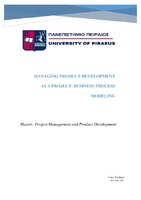| dc.description.abstractEN | The scope of this thesis is to represent all the “basic” methodologies which are used in order to execute a project either it is referred as a product or a service or result. Then, a more extensive analysis regarding product development will be presented, as well as the confrontation of product development as a project. Analyzing all the product development processes and designed them by using BPMN model. Organization’s point of view about how they handle a project has been significantly changed. Nowadays, every single organization pays a lot of attention on feedback, which is implemented in the whole duration of a project, as well as in the continuous and direct communication with the customer. Continuous development attracts also organizations’ attention as it has proved results that help them to adapt the changes during a project. All the above consist important factors that companies have been turning on using more flexible methodologies so that handle both their projects individually and their portfolio of projects. The fast technology growing constitutes one more factor which affect to a large extent company's’ performance, which means that they are leaded to need to be adaptable more than ever. Finally, not only the continuous increasing requirements by customers, but also the oversupply of competitors are factors which
contributes significantly in strategic business choice of every organization, one of which is the appropriate business process model they are going to use in every case in order to acquire the competitive advantage in market.
The opportunity of having feedback during the whole processes of a project has as a result to prevent actions, which could be characterized as corrective actions, in order to complete the project as much as possible following the initial and planned specifications. In the traditional methodology of waterfall project management, feedback is something which comes after the completion of the project, thus changes are too hard to be implemented. However, in other more flexible methodologies such as Scrum project management in every stage (sprint) of execution feedback is given, fact which not only helps in the continuation of the project by better decision-making, but also contributes in a successful completion of a project.
The scope of this thesis is to represent the product development as a project, all the processes which are needed during this project, which will be designed by Business Process Modeling Notation (BPMN) using both traditional methodology (waterfall) and scrum project management. Through this, not only all the differences, but also the similarities between the two methodologies would be represented graphically. | el |



